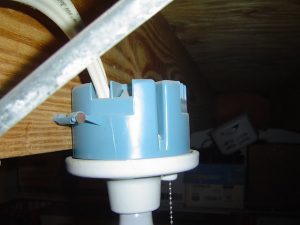Step-by-Step Instructions on Fishing Electrical wire from an Attic Ceiling to an Electrical Wall Switch
By Mark J. Donovan
|
|
Snaking electrical wire in walls and ceilings can be a time consuming and frustrating experience. I recently snaked an electrical wire from an attic ceiling down to a switch electrical box in a wall in an effort to install a new ceiling light. Half of my time spent installing the new ceiling light involved snaking the electrical wire, however I was successful, and in the end that’s what really matters. Summarized below are a few tips to help you in snaking electrical wires in walls and ceilings.
Tools Required for Snaking Electrical Wires in Walls and Ceilings First, you need a few key tools. Ideally you should have a fish tape. A fish tape is a long thin, flat piece of steel wire. |
It is coiled and encased in a plastic housing and comes in common lengths of 50 and 100 feet. The end of the fish tape has an eye that electrical wires can be connected to so that they can be pulled through walls, ceilings and conduit pipes.
Though a fish tape is ideal, you may be able to get away without it if you have a short distance to snake a wire. In my recent project, I simply used a 6 foot length of 14 gauge bare copper wire as my snake.
In addition to the fish tape or snake wire, a flashlight, hammer, drill, ¾” spade drill bit, screwdriver, needle nose pliers, and adjustable pliers are also helpful.
| Snaking Electrical Wires
To snake, or fish an electrical wire, start by turning off power at the main circuit panel to the electrical box you plan on snaking a wire to. After power is turned off at the electrical box, remove the electrical switch from the electrical box. With the switch out of the box use your hammer, screwdriver and pliers to remove a knockout tab in the back of the electrical box. |
 |
Next, go into the attic and locate the top plate of the stud wall that contains the electrical switch box. This can be a tricky process. Before going into the attic, look for some reference points that transmit up into the attic area. For example, if there are ceiling fans or air conditioning vents in the ceiling or walls near the electrical box make a note of their distance away from the electrical box. You can use this information to help locate the stud wall in question, and even the specific location of where the electrical box sits below the top plate of the stud wall. Another tip is to look for an electrical wire that may already feed down from the attic into the electrical box.
Once they have pulled the wire or fish tape through the electrical box the hard part is over. If you simply used a length of wire as your snake, attach at your end of the snake the electrical wire. Have your partner then continue to pull on the wire snake until they finally pull the electrical wire through the electrical box. If you used a fish tape, then have your partner fasten the electrical wire to the end of the fish tape, and then you pull back on the fish tape to pull the wire up through the hole in the attic stud wall.
Once you have snaked the electrical wire between the electrical box and the attic, you can then proceed to wire up your ceiling light.
For help on building a new custom home, see HomeAdditionPlus.com’s New Home Construction Bid Sheet. The New Home Construction Bid Sheet provides you with the knowledge on how to plan a custom home building project, and what to look for when hiring contractors for your new home construction. It also includes a detailed cost breakdown table and spreadsheet for estimating your own new home construction building costs.
Related Information
- What is a Ground Fault Circuit Interrupter Breaker
- How to Rough in Electrical Wiring
- How to Pull Romex Wire through a Wall
Additional Electrical Wiring Resources from Amazon.com
 |
 |
Free Home Addition Price Quotes with No Obligation!
Fill out our 3-5 minute quick and easy form, and receive a free price quote on a house addition from one of our prescreened and licensed home addition contractors. This process is free and there is no obligation to continue once you receive your house addition price estimate.

